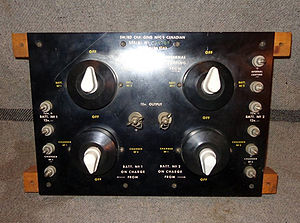Switchboard Charging No.C5 Canadian
| Switchboard, Charging No.C5 Canadian | |
|---|---|
 | |
| Specifications | |
| Length | 18-1/2” |
| Width | 5” |
| Height | 11-1/4” |
No. 5 Switchboards were most often seen in wireless trucks even if that truck had a factory supplied panel. This was not only to standardize, but in many instances the existing vehicle system was insufficient to operate the more modern wireless equipment and batteries. Also, the No.5 Switchboard could be removed and used from a remote location such as a penthouse or trench if required.
The unit was 18-1/2” wide by 11-1/4” tall by 5” deep and consisted of four ceramic ‘stove’ switches with porcelain knobs set in a bakelite panel. The switch knobs only turned clockwise (lifting and turning counter clockwise removed them) and each switch was protected by a plastic cover. The top left switch determined which pair of batteries supplied the wireless set, the top right controlled ‘internal lighting’ and the two lower ones were to select which generator charged which pair of batteries. Terminal posts running down either side were supplied to attach two pairs of batteries, two generators and output for ‘internal lighting’ which could also be used as a generic 12V DC supply for anything that required it. Two additional posts in the centre were the positive and negative 12 volt output for the wireless set. The bakelite front panel was secured to two wooden battens that were also the mounting points, and the battens to a plywood backing panel. The space between the front and back panels was open so the switchboard was not waterproof.
There was a British ‘Switchboard Charging No.5’ which featured larger switches, scalloped knobs and vinyl coated solid core copper wiring. As well there was a modified Canadian unit with additional terminal posts made for use with the No.19 Amplified wireless set.
Related Pages
- No related pages at this time
Related Items
References
- ↑ Information courtesy of Bruce Parker



